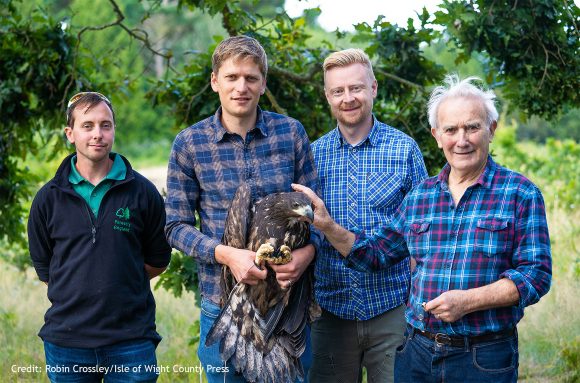The first white-tailed eagles to be reintroduced to England have been released on the Isle of Wight. The six young birds, the first to be returned to southern England for 240 years, are part of a five-year programme to restore this lost species led by Forestry England and the Roy Dennis Wildlife Foundation.
The young birds were collected under a Scottish Natural Heritage licence from the wild in Scotland and brought to the Isle of Wight. Here they have been fed and monitored by a team of experts and dedicated volunteers whilst becoming familiar with their new surroundings. All six birds have made good progress and have now been successfully released. The team will initially continue to provide feeding sites for the birds to encourage them to settle along the south coast.

Before being released the birds were fitted with small satellite trackers so their progress can be closely monitored. Data on their movements will be available on the Roy Dennis Wildlife Foundation website and once the birds are well established it is hoped that they will become a familiar site over the skies of the Island and nearby mainland coast.
Roy Dennis, Founder of the Roy Dennis Wildlife Foundation said:
“I have spent much of my life working on the reintroduction of these amazing birds and so watching them take to the skies of the Isle of Wight has been a truly special moment. Establishing a population of white-tailed eagles in the south of England will link and support emerging populations of these birds in the Netherlands, France and Ireland, with the aim of restoring the species to the southern half of Europe. The team is pleased that the project fulfils one of the specific aims of the Government’s 25 year Environment Plan.
“We have seen from other reintroduction programmes that returning lost species offers real benefits for nature and the health of our environment, and to people and local economies. I would like to thank everyone from the local community who is working with us to support and manage this project including our volunteers and project officer who are all Isle of Wight residents. We are also very grateful to the private donors who are supporting the project.”
Bruce Rothnie, Forestry England’s South District Forest Management Director, said: “The diversity of our wildlife is under real pressure with many species now in long-term decline. The nation’s forests provide an important habitat for wildlife and are playing a critical role in supporting the successful re-establishment of many lost or threatened species. We are immensely proud that the woodlands we manage on the Isle of Wight and surrounding South Coast are now home to these incredibly rare birds as they return to England’s coastline.”
The Isle of Wight was chosen as the location to reintroduce the white-tailed eagles, also known as sea eagles, as it offers an ideal habitat for these coastal loving birds. Areas where the cliff edges have slipped will provide quiet areas for the young eagles, and its network of cliffs and woodlands provide many potential nesting sites. The Solent and surrounding estuaries will provide a rich food supply for the eagles, with fish such as grey mullet and water birds forming a key part of their diet.
The Isle of Wight was also chosen for the project given its central position on the south coast allowing the birds to disperse east and west along this coastline.
A comprehensive feasibility study and public surveys were conducted prior to reintroduction and a steering group made up of local organisations and members of the community has met and is helping to guide the project.
The project is also expected to make a significant contribution to the local economy. A similar scheme on The Isle of Mull was found to have boosted its local economy by up to £5 million a year, demonstrating the interest in this iconic bird.
The reintroduction of Britain’s largest bird of prey is being conducted under licence from Natural England, the Government’s wildlife licensing authority. Further releases of the birds will take place annually as part of the five year programme, with at least six birds released each year. It will take several years for the young birds to become established and breeding is not expected to start until at least 2024.
Chairman of Natural England, Tony Juniper, said:
“The return of these spectacular birds to England is a real landmark for conservation. I very much hope that it will also provide a practical demonstration of the fact that we can actually reverse the historic decline of our depleted natural environment.
“It will also show how helping the recovery of our wildlife can be done at the same time as bringing benefits for people, in this case by offering a boost to the local economy through wildlife tourism, as has happened in Scotland after these birds were reintroduced there back in the 1970s.
“As with all applications to restore lost native species, Natural England carefully considered the short and long term impact of reintroducing the eagles on the environment, including implications for local communities as well as the impacts on the animals themselves.
“Everyone at Natural England is delighted to see this project reach this stage and I know just how excited Roy Dennis and the Forestry England team are about this reintroduction. I’m sure the local community will share their passion and excitement and look forward to seeing these magnificent creatures return to our skies.”
Read more at http://www.roydennis.org/



